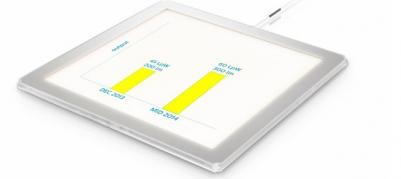The LED Tech Talk show hosted Dietmar Thomas, Philips' OLED communication and brand manager (and also my personal friend). Philips talks about the company's current OLED lighting offering and their expectations for the near future.
Dietmar actually says that OLEDs are ready for the general lighting market - and by general lighting he means stuff like emergency exit signs, signage in general and under-the-shelf lighting. Philips also sees OLEDs enter the residential lighting market, but this will only happen in 2017 or so.
Philips' OLED performance increased dramatically in the past 2-3 years. Their most advanced panel (the GL350 Gen-2) offers 200 lumens and 45 lm/W. In mid 2014, Philips expects to release a panel (the GL350 Gen-3?) that will be brighter (300 lumens) and more efficient (60 lm/W). The performance is actually increasing faster than Philips thought before.

Finally, Dietmar promises some cool new OLED stuff to be shown at the Light & Building fair in April - including a much larger panel (25cm in length) - that will be brighter. So hopefully this means that the GL350 Gen-3 panel, which will feature 300 lumens and 60 lm/w.
Comments
Steve, achieving 60 lm/W requires phosphorescent emitters - that's for sure. But the deal with UDC was only signed in November so I'm not sure if the new panel (which was already in development then) uses the UDC's PHOLEDs. We'll have to wait till the official announcement...
If it's phosphorescent, I would be amazed that they can improve the lifetime at the same time.
Good luck in the emergency sign market. 60 lm/W is still only half of what you get with an LED lightsource and especially in the emergency signs market it is all about efficiency and lifetime.
Shelf lighting might be a different story though...
Can you directly compare output from OLED to LED though? The OLED is emitting that much light across the entire surface, while the brighter LED needs to be dispursed through lenses.
You cannot compare LED and OLED directly, but you can compare overall system efficiency of the luminaire.
LED luminaires now regularly top 100 lm/W even those where the light is distributed over a whole surface such as emergency luminaires. The top manufacturers are probably going to show first examples of 120 lm/W at Light&Building and that still is not the end of the line. OLED still barely manages 1/2 of that by any measurement.
And as I said: In emergency it is mostly about how long can the luminaire be operated on battery power. 50% less efficiency is not really a good selling point in that case. Uniformity may help the OLED a bit, but probably only in like the top 1% of the market.
Not trying to say OLEDs are bad. They are great. Problem is we have two disruptive technologies fighting each other in lighting with LED having a sizeable headstart. My guess is that OLED will find it extremely hard to establish a sizeable market presence until LED development levels of to some degree.
Please also consider that 60 lm/W for OLED is without any light out-coupling enhancement and 200 lm/W for LED is without calculating the lost of the whole lighting package. For OLED, after the external and internal light out-coupling methode, the efficiency could easily x2, i.e. 120 lm/W.
The problem for OLED lighting is not efficiency but lifetime and cost. Both are not easily overcome because of the lack of capital investmentof the technology worldwide.
If 120 lm/W is so easily done with OLEDs then I am wondering why Philips, LG, Samsung and all the other companies working on this are barely scratching 60 lm/W right now.
In the future things may look different. I know that 120 lm/W are possible in principle and I know that this and more has been shown in some labs. However there is difference between lab results and a commercial product.
Current good phosphorescent emitters are based on Iridium which is very expensive and rare. Lanthanide emitters might be another good option.


Ron Could the rapid increase in performance be attributed to PHOLEDs ???
Thanks Steve